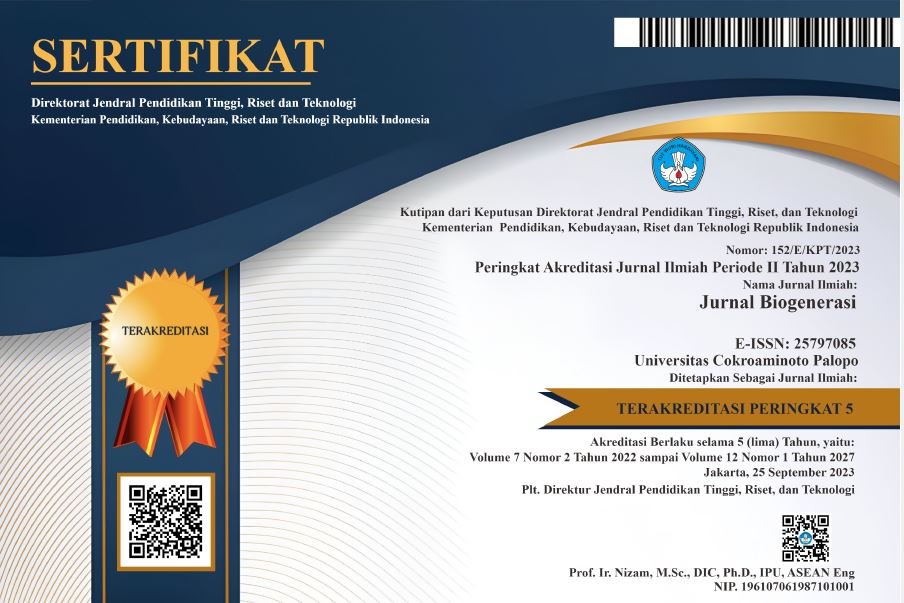ANALISIS PENGETAHUAN DAN SIKAP KESEHATAN REPRODUKSI SISWA SMP NEGERI 3 MALUNDA
DOI:
https://doi.org/10.30605/biogenerasi.v10i2.5440Keywords:
knowledge, attitudes, reproductive healthAbstract
This research is a quantitative research using a survey method which aims to determine the level of knowledge and attitudes about reproductive health of students at SMP Negeri 3 Malunda. The population in this study was Class IX of SMP Negeri 3 Malunda, sampling used the census method to obtain a sample size of 91 students. The research instrument used was questions about reproductive health, a total of 25 items and 25 questionnaire statements about attitudes. The research data was analyzed by calculating the average and percentage and then categorizing it. The research results show that the level of knowledge of Class IX students at SMP Negeri 3 Malunda is included in the interval category 71 to 86 with the description "good" out of 91 total students, while the reproductive health attitudes of Class IX students at SMP Negeri 3 Malunda are included in the interval category 71 to 85 with the description "good" out of 91 total students.
Downloads
References
Astuti, T. (2019). Faktor-faktor yang memengaruhi pengetahuan dan sikap remaja tentang dampak rokok bagi kesehatan reproduksi di dusun I Desa Bakaran Batu Kecamatan Percut Sei Tuan Kabupaten Deli Serdang. Excellent Midwifery Journal, 2(2), 74–77.
Astutik, & Fuji. (2020). Peningkatan Pemahaman Penanganan Kesehatan Mental Integratif (Psikologi dan Keislaman) Melalui Video Promotif Title. Journal of Behavior and Mental Health, 1(2), 55–60.
Ayunimirta, T., & Anindita, S. D. (2022). Edukasi melalui Medsos guna Optimalisasi Kemampuan Sosial Emosional dan Kesehatan Reproduksi Remaja di Sulawesi Barat. Jurnal Widyaiswara Indonesia, 3(4), 169–176.
Cokorda, & Puspa, S. (2022). Gambaran Pengetahahuan dan Sikap Remaja Putri Terhadap Kesehatan Reproduksi Pada Siswi SMPN 1 Ubud. E Journal AMJ, 2(3), 137–142.
Damiati, et al. (2019). Perilaku Konsumen. Depok: PT RajaGrafindo Persada.
Darwis, D., & Fadjarani, S. (2016). Hubungan Antara Pengetahuan Dan Sikap Pelestarian Lingkungan Dengan Perilaku Wisatawan Dalam Menjaga Kebersihan Lingkungan. Jurnal Geografi, 4(24), 37–49.
Fitriani, & Abe, D. A. (2023). PENGETAHUAN DAN SIKAP REMAJA PUTRI TENTANG KESEHATAN REPRODUKSI DI SMA NEGERI I LORE UTARA. Jurnal Ilmiah Kesmas IJ, 23(2), 105.
Galbinur et al., ( 2021). Pentingnya Pengetahuan Kesehatan Reproduksi bagi Remaja. Prosiding SEMNAS BIO, 221-228.
Gustiawan, R., Mutmainnah, M., & Kamariyah, K. (2021). Hubungan Pengetahuan dan Religiusitas dengan Perilaku Kesehatan Reproduksi pada Remaja. Jurnal Ilmiah Ners Indonesia, 2(2), 89–98. https://doi.org/10.22437/jini.v2i2.9970
Hairil, A., et al. (2021). Teori Kesehatan Reproduksi. Aceh: Yayasan Penerbit Muhammad Zaini.
Kusumastuti, D. P., & Lismidiati, W. (2018). Hubungan Pengetahuan dan Sikap tentang Kesehatan Reproduksi dengan Pemanfaatan PIK-KRR. Jurnal Keperawatan Klinis Dan Komunitas, 2(3), 135–144.
Mahmud. (2010). Psikologi Pendidikan. Bandung: CV Mustika.
Mukhlida, et al. (2021). Metodologi Penelitian Kesehatan. Aceh: Yayasan Penerbit Muhammad Zaini.
Nessi, M., Maryanah, & Willa, F. (2018). Kesehatan Reproduksi Remaja :Implementasi PKPR Dalam Teman Sebaya. Malang: Wineka Media.
Notoatmodjo. (2010). Ilmu Perilaku Kesehatan. Jakarta: Rineka Cipta.
Novita, A., Cahyaningsih, O., & Indah, S. (2022). Hubungan Pengetahuan Dengan Sikap Remaja Tentang Kesehatan Reproduksi di SMK Bina Nusantara Kab Semarang. Seminar Nasional Widya Husada, 10(1), 1–52.
Rosita, et al. (2024). Asuhan Kebidanan Pada Kesehatan Reproduksi Wanita. Jamber: PT. Sonpedia Publishing Indonesia.
Setiawati, D., Ulfa, L., & Kridawati, A. (2022). Pengaruh Pendidikan Kesehatan terhadap Sikap Remaja tentang Kesehatan Reproduksi. Jurnal Ilmu Kesehatan Masyarakat, 11(04), 322–328. https://doi.org/10.33221/jikm.v11i04.1453
Sujarweni,V.Wiratna, (2018), Metodologi Penelitian Bisnis dan Ekonomi Pendekatan Kuantitatif. Yogyakarta: PSTAKABAPUPRESS.
Uberty, A. (2022). Pencegahan perilaku kesehatan reproduksi yang beresiko pada remaja. Pekalongan: PT. Nasya Expanding Management.
Yati, D. (2024). Strategi efektif edukasi kesehatan reproduksi Remaja. Bantul: CV. Mitra Edukasi Negeri.
Yessi, H., Hastuti, M., & Elmia, K. (2015). Teori Kespro. Yogyakarta: CV Budi Utama.
Yusfarani, D. (2020). Pengetahuan Dan Sikap Mahasiswi Program Studi Pendidikan Islam Anak Usia Dini (Piaud) Tentang Kesehatan Reproduksi. Jurnal ’Aisyiyah Medika, 5(1), 21–35.
Downloads
Published
How to Cite
Issue
Section
License
In submitting the manuscript to the journal, the authors certify that:
- They are authorized by their co-authors to enter into these arrangements.
- The work described has not been formally published before, except in the form of an abstract or as part of a published lecture, review, thesis, or overlay journal.
- That it is not under consideration for publication elsewhere,
- That its publication has been approved by all the author(s) and by the responsible authorities – tacitly or explicitly – of the institutes where the work has been carried out.
- They secure the right to reproduce any material that has already been published or copyrighted elsewhere.
- They agree to the following license and copyright agreement.
License and Copyright Agreement
Authors who publish with this journal agree to the following terms:
- Authors retain copyright and grant the journal right of first publication with the work simultaneously licensed under Creative Commons Attribution License (CC BY 4.0) that allows others to share the work with an acknowledgment of the work's authorship and initial publication in this journal.
- Authors are able to enter into separate, additional contractual arrangements for the non-exclusive distribution of the journal's published version of the work (e.g., post it to an institutional repository or publish it in a book), with an acknowledgment of its initial publication in this journal.
- Authors are permitted and encouraged to post their work online (e.g., in institutional repositories or on their website) prior to and during the submission process, as it can lead to productive exchanges, as well as earlier and greater citation of published work.


.png)

